Issues that should be decided at the 29 November Victorian State elections
 |
Victorian voters could on Saturday 29 November begin to take back their state Parliament from the vested interests that are now running Victoria. If presented with open, informed discussion there is every reason to hope that a far larger proportion of Victorians than in previous years will vote for good independent or small party candidates and not for either of the two major parties. |
The policies listed below are much of what I would like to see from the new Victorian government after 29 November. I believe that, if presented with the policies listed below, most Victorians would support them or, if not at first, would after open debate and discussion. So this document is intended to be guide to Victorians as to which of the candidates to vote for on 29 November, depending on the candidates' response to my survey, which I intend to publish here in coming days. 1
If you support these policies, and you know of a candidate in your electorate who also supports these polices, please consider offering to help him/her. Alternatively, if there is no candidate who supports these policies standing in your electorate or upper house region, the why not consider nominating yourself? 2
The policies
More government participation in the economy
1. No privatisation of any asset in which large numbers of Victorians have a stake, for example the Port of Melbourne. 3 No privatisation of public buildings and public land. As the means to do so become available, reverse privatisations which have occurred since the time of the Kirner Labor Government in the early 1990's. Conduct a pubic audit of these privatisations.
2. Expand the size of state government work force. The goal is for each Victorian who needs work to be offered work in a occupation which provides useful services to the community and which matches his/her interests and has on-the-job training and career structure. Private employers to be encouraged to do likewise.
3. Public Bank of Victoria to be established. It is to be run like the Bank of North Dakota in accordance with the principles of the United States Public Banking Institute. 4
Full employment in secure and fulfilling occupations
4. Oppose high immigration and dismantle the Live in Victoria website. 5
5. No section 457 visas where there are local tradespersons. Employers must prove that they have attempted to train local workers before they are allowed to import new workers with 457 visas.
6. Abolish sweat-shops in which illegal foreign workers are exploited. Employers found to have illegally exploited foreign workers in such factories to be prosecuted and jailed. Any public officer found to have been complicit in these sweatshops to also be prosecuted and jailed.
7. Immediate reduction of working hours to 35 hours 6 with further reductions in the near future.
8. Flexible part-time working hours to be offered to government workers who wish to work less than a full week's work. 7 Private employers to be encouraged to do likewise.
9. Create government enterprises to compete with private business. This will provide incentives for privately owned business better services and charge less. 8 Government enterprises to include: real estate, funerals, car dealerships, equipment hire and land development.
10. Re-build Australian manufacturing in Victoria. 9 The government to plan the rebuilding of manufacturing with the private sector. Protective tariffs to be imposed to protect manufactured items as agreed to in the plan.
Effective town planning
11. Reduction of commute times through better town planning and better public transport.10
12. End approval for high rise apartments.11 At most, allow medium density housing of heights of no more than 3 stories close to parkland, bushland, shops, schools and other amenities.
13. Preserve spaces for community activities.12 Re-establish community spaces where they don't exist.
14. Public liability insurance funding to be established for community events as done in NSW.
15. Secure shelter to be provided as a right.13
Reduce waste, make Victoria sustainable
16. No over-packaging, demand effective recycling.14
Computers, information technology and the Internet
17. Free open source software15 to be used in all government departments, statuary authorities, TAFE colleges and schools. Private companies and institutions to be encouraged to do likewise. The Victorian government to make generous financial contributions to the providers of open-source software.
18. Establish a free social network on the Internet as an alternative to Facebook, Google and Twitter. That social network is to respect the privacy of its users and be free, transparently run and without commercial advertising.16
Open Government
20. No "commercial in confidence" contracts18.
Consumer rights
21. Outlaw built-in obsolescence. Manufacturers and importers of products with built-in obsolescence to be prosecuted.19
22. Encourage food self-sufficiency. Wherever possible, make land available to local communities so that they can emulate extant local initiatives such as Down's Estate at Seaford Wetlands. Available members of the Down's Estate group and others with expertise to be hired by the government to instruct other communities.
Biodiversity protection and respect for other species
23. Preserve remaining native flora and fauna. Re-vegetate urban areas to provide additional living space for endangered wildlife.
24. Avoid disturbance of established wildlife populations so that their social organisation and local biofeedback is preserved since this will tend to regulate their population in line with territorial and migratory rules
25. Outlaw the harassment of possums, such as the banding of palm trees with bands of steel by the St Kilda Council to prevent possums being able to climb the trees.
26. Protect wildlife with strategic underpasses and overpasses on freeways. To protect wildlife, these are to be mandatory on all new roads and retrofitted to older roads within 10 km of green spaces in order to maintain migratory pathways.
Improving the health of Ordinary Victorians
27. Fund research to determine if processed food
bought from food retailers is harmful to our health20
28. Government employees to share office duties with outside manual workers to remove health hazards caused by long hours of physical inactivity21, Private employers to be encouraged to do the same for their workers.
Protection of civil liberties, freedom of speech
29. Outlaw indiscriminate telecommunications surveillance22 of Victorians as revealed by Julian Assange and Edward Snowden and others.
30. Acknowledge the debt of gratitude that the Victorian people owe to fellow Victorian Julian Assange and protect him from unjust persecution.23
31. Acknowledge the debt of gratitude that the Victorian people owe to Edward Snowden.24
About the author
I stood in the 2009 Queensland state treasurer in the seat of Mount Coot-tha against then Treasurer Andrew Fraser. (prior to that on 15 March 2008, I had also stood against the current Queensland Premier Campbell Newman for Lord Mayor of Brisbane.) Articles about that election and my campaign can be found here. The reason I stood was I wanted to stop the further privatisation of Queensland's public assets which had started under the previous premier Peter Beattie. Amongst other assests Beattie privatised the State Government Insurance (SGIO - as it was then know, it is now known as 'Suncorp') and the Golden Casket lottery corpration, neither with any electoral mandate. I feared that then Premier Anna Bligh planned to privatise more public assets and that no other candidate was going to raise the issue. Sadly, I was right about both concerns (although one member of the Queensland, Dorothy Pratt, the independent member for Nanango until she retired in 2012 spoke, in Parliament against privatisation).
Whilst the Greens had stated their opposition to privatisation, they did not raise that issue during the election campaign as far as I was aware. Had they done so, they would almost certainly have a received a much better vote and considerably improved the prospects for success of the subsequent campaign against privatisation.
After the election Queensland Premier Anna Bligh claimed that she had suddenly discovered that debts owed by the Queensland Government and that necessary public expenditure on government programs made privatisation of a number of assets necessary. These assets included:
- Queensland Motorways Limited (Operating the Gateway Bridge and Logan Motorway tolling systems);
- The Port of Brisbane Authority;
- Forestry Plantations Queensland;
- Abbot Point Coal Terminal; and
- Coal carrying rail lines, currently owned by Queensland Rail (QR Passenger services will remain nationalised).
Sadly, I had been injured almost fatally on 10 May 2010, when a four wheel drive ran into me on my bicycle on my way to work. I was lucky not to be killed. My brain was concussed and I suffered diffuse axonal brain damage. Consequently I am not able to work as effectively as I once could (although people tell me that my intellect, if not my memory, coordination and stamina, is about as good as it was before my injury).
Because I was disabled, I was not able to stand in the Australian Federal Elections of 21 August 2010 and the Queensland state elections of 24 March 2012. If I had, I would surely have got a much higher vote in both.
As a result of public outrage at Premier Bligh's asset sell-off, the Labor Party was routed by Liberal/National leader Campbell Newman in the 2012 state elections. Since then, contrary to the clear wishes of Queenslanders, Queensland Premier Campbell Newman is now proceeding with his own program of yet more privatisations.
This sad experience demonstrates that neither of the major parties offer any real alternative to voters, who will have to find an alternative elsewhere.
Footnotes
1.↑ in 2009, prior I conducted a survey of all the candidates who were intending to stand in the Queensland elections to be held that year. The results were posted here on 18 Mar 2009. Recently, In Victoria, a survey was conducted regarding the Victorian music industry on 17 September on TheMusic.com. The results of its survey can be found in this report card (pdf, 57K).
2.↑ You can nominate between Wednesday 5 November and 12 noon on Friday 14 November. That gives you over a week to nominate. If you do nominate, please be sure let us know by either posting a comment at the foot of this page or by contacting us through the contact page so that we can support you.
3.↑ Privatisation is not to occur unless it can be shown from the public audits of past privatistions, that the claims, made by its proponents, that privatisation was beneficial to Victoria and made the economy more efficient were correct. This claim is against intuition and all of the evidence of which I am aware.
4.↑ Eventually the Public bank of Victoria could also be expanded to become a nationwide public bank like the old Commonwealth Bank of Australia before it was privatised by the Keating Government between 1991 and 1996 with no electoral mandate. Also, read Web of Debt (2007 ... 2013) The Public Bank Solution (2013) by Ellen Brown.
5.↑ Live in Victoria is Victorian Government website which encourages high immigration which causes more crowded public transport, more congested roads, higher housing costs and higher unemployment and other social, economic and ecological problems. Whilst population growth, which increases the number of people amongst which amenities and natural resources must be shared, cannot possibly improve the quality of life of Victorians already living here, a small minority, perversely gain from everyone else's loss. This includes property speculators who gain from increased demand for shelter.
6.↑ Over 35 years ago, in the late 1970's the trade union movement launched an industrial campaign for a 35 hour week. The stated goal of the campaign was to share the available work around so that nobody was out of work. Under Bob Hawke's leadership the Australia Council of Trade Unions (ACTU) quickly adopted the cop-out compromise demand for a 38 hour week. The 38 hour week was eventually won, but the longer term goal of further reductions in the working week was forgotten. Only a minority of today's workers still enjoy that token reduction in working hours. Many work much overtime as an economic necessity because of ever-increasing house prices, mortgage payments, rent and the many other living expenses of Australia's dysfunctional economy. Many are forced by their employers to work overtime and some even bullied into working unpaid overtime.
On top of that, creeping credentialism has made it necessary for ever more of the workforce to improve their skills by undertaking TAFE and tertiary courses in their own time at their own expense.
Possible exceptions to reduced working hours may be justified for a small minority of the workforce which truly enjoys its tie at work (for example, some research scientists).
7.↑ One reason why some workers prefer to work less hours and get paid less is that they own their own home and don't have to pay rent or mortgage. Rather than earning more money to spend on material acquisitions, they would prefer to spend more time away from work in activities they enjoy – painting, writing, gardening, bushwalking, etc..
8.↑ Should this cause some private businesses not to be financially viable, employment to be offered to employees of those businesses where they have sufficient merit.
9.↑ The destruction of Australia's manufacturing industry was the direct result of decisions made by the Labor governments of Bob Hawke and Paul Keating. Shortly after Labor was elected in 1983, Paul Keating, as Federal Treasurer and with no electoral mandate, embraced global 'free market' policies beginning with the floating of the Australian dollar. (In part, this was an extension of the initial reduction of protective tariffs curiously adopted by the otherwise progressive government of Gough Whitlam in 1975.)
To rebuild the manufacturing base that Australia once had will not be easy nor can occur without Australians incurring some economic hardship, but no country without the skill or expertise to build technologies that are comparable to those of other countries in its region can hope to resist colonisation.
10.↑ Set a goal that 90% of Melburnians should require no more than 10 minutes to cycle to work. Public transport to be provided for those who need to travel further.
11.↑ High rise accommodation is presented as a way to reduce urban sprawl. Instead of being forced to live on the outskirts of Melbourne with few local amenities, no public transport, and an immensely long drive to work, Melburnians can now choose to live closer to work and amenities, in tiny high-rise apartments a long way above dirt, natural vegetation and what little native wildlife there may be.
There is much additional cost to living in these crowded high-rise apartments that is not borne by free-standing home dwellers. This includes additional energy costs for air conditioning, for travelling up and down lifts and for lighting the stair wells. Furthermore, more people will have to share the local infrastructure surrounding the new high rises.
12.↑ Many of the locations, both undercover and in open spaces, where community groups could easily meet at little or no cost, have been sold off in the wave of privatisations which have occurred since the 1990s. The audit called for in policy 1 will show which spaces were once publicly owned and when and by whom they were sold off.
13.↑ Ideally, homes should be owned by the occupants. Until this is possible, the quantity of government-owned rental stock should be increased. Private renters should be better protected. In general, rents should not be raised higher than the CPI. Leases should not be terminated without good reason. Such a reason might be that the landlord himself/herself requires shelter.
14.↑ Through economic incentives, ensure that only the minimum amount of packaging necessary to carry, store and label the product is used. Manufacturers and retailers, particularly supermarkets, to be taxed to pay the cost of landfill necessary to dispose of waste from their products.
Abolish aluminium drink cans. All drinks and beverages to be sold in containers of standard shapes and sizes for which a refundable deposit is to be paid. I recall with my memory, such that it is, that maybe, about 15 years ago, somebody put up a proposal that all beverages (meaning to include, I think, drinks, sauces, preserved fruit and vegetables and sandwich spreads) be sold in refundable glass containers, which are to be made to standardised shapes and sizes. This sensible and innovative proposal was clearly not adopted. Could anyone else who is aware of this proposal please provide me with specific details about the proposal, including: when was it proposed, by whom and did the authorities offer any reason given for the proposal not being adopted?
15.↑ Open source software should be used in place of expensive proprietary software such as Microsoft Windows and Microsoft Word wherever possible.
Scandalously, the Microsoft Corporation also put in Windows, software that caused a computer, when connected to the Internet, to directly send to the NSA spy computers about which Edward Snowden blew the whistle, much of the information contained on that computer including e-mail addresses, e-mails, other documents, web sites visted and passwords. to spy on every computer connnected to the Internet through its blanket surveillance exposed by whistleblower Edward Snowden.
Open source software includes the Linux and FreeBSD operating systems and virtually all of the network (TCP/IP) software which drives the Internet. Open source applications software includes the LibreOffice office suit which can be used in place of Microsoft Word, Microsoft Excel and Microsoft Access. Web-sites from which open-source application software can also be downloaded includes Source Forge, Git Hub and Apache. Much of this free application software can also be run on computers which run the proprietary Microsoft and Apple operating systems.
16.↑ Possibly such a free, transparent and non-profit-driven social network is already in existence. If such a network can be identified, the Victorian government should offer generous financial support to it.
17.↑ No government information is to be kept from public without good reason. Appoint independent adjudicator to handle disputes where government officers do not wish to disclose requested documents. Adjudicator to report to parliament at least twice every year.
18.↑ A good example is the extortionately expensive East-West Link project. Why the Victorian government felt it necessary to sign a "commercial in confidence" contract has never been explained to the Victorian public as far as I am aware.
19.↑ Built-in obsolescence includes non-availability of affordable spare parts. Wherever built-in obsolescence can be proven, those who designed the product should be prosecuted for conspiracy.
20.↑ The research could be performed by university researchers or government staff. There is much anecdotal evidence, in addition to credible scientific research, which indicates that the consumption of highly processed foods which contain sugar, corn syrup and other additives may be harmful to our health and contributing cause to obesity, diabetes, heart disease and other ailments.
21.↑ One of the biggest killers today is office work. If office workers were to perform manual work for part of the week, the threat to their health from sitting for hours at a time would be considerably reduced. Also, fewer office workers would not need to spend so much of their leisure time in gyms to stay healthy.
22.↑ Surveillance only to be permissible where it can be shown to the Victorian police that the people to be spied upon pose a risk to the community.
23.↑ The Victorian government to acknowledge the debt of gratitude that the Victorian people owe to Julian Assange for his decades of tireless activism for free speech, against surveillance and against war. The Victorian Government to demand of the UK government that Julian Assange be granted safe passage to Victoria. Requests by the the United States government for the extradition of Assange to be refused. Requests by Swedish Government for extradition to be refused unless Sweden guarantees to refuse extradition requests from the United States. Should the Swedish Government refuse, offer to hold trial of Julian Assange in Australia. If it is found that the charges of rape against against Assange have no basis, pursue a damages claim against the Swedish government on behalf of Julian Assange.
24.↑ The debt of gratitude is for Edward Snowden's revelation of the scale of surveillance by the United States' NSA and the United Kingdom's GCHQ on the citizens of the UK the US, Australia, New Zealand and New Zealand. Offer to Edward Snowden the right to travel to Victoria with a guarantee that extradition requests from from the United Sates would be refused.


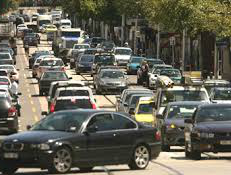


 Welcome. I always worried about population but I believed the demographers who said it would take care of itself. They were wrong, so I stopped listening to them. I kicked off a national debate about this issue in 2009. The points I made were about endangered species, climate change, traffic, housing, and the cost of living and the problems of Australia at 36 million. In 2010 there was movement - from the Greens, the Liberals, Kevin Rudd at Easter establishing a Population Minister, and Julia Gillard renouncing Big Australia. The election came and went, but there was no action. I don't know why Julia never delivered on this - I personally think she might still be PM today if she had.
Welcome. I always worried about population but I believed the demographers who said it would take care of itself. They were wrong, so I stopped listening to them. I kicked off a national debate about this issue in 2009. The points I made were about endangered species, climate change, traffic, housing, and the cost of living and the problems of Australia at 36 million. In 2010 there was movement - from the Greens, the Liberals, Kevin Rudd at Easter establishing a Population Minister, and Julia Gillard renouncing Big Australia. The election came and went, but there was no action. I don't know why Julia never delivered on this - I personally think she might still be PM today if she had.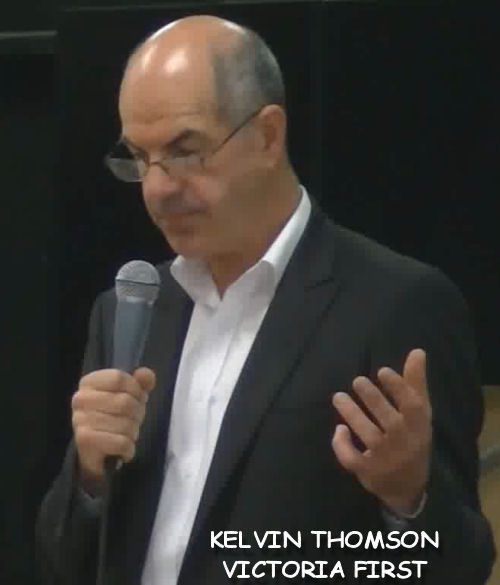 In political debate people are very frightened about being called racist or xenophobic. This is true of Prime Ministers and also of the people who live in our street. Yes there are racists out there, it's a pity, but it's true. But the use of the term racism has become a new kind of McCarthyism, used to stifle debate. Just as there were communists in the 1950s, but the fear of communists was used in an hysterical way to shut down and discredit and attack all kinds of political ideas that the McCarthyists disliked, so too now we see the name calling used to stifle and shut down debate on things we desperately need to debate.
In political debate people are very frightened about being called racist or xenophobic. This is true of Prime Ministers and also of the people who live in our street. Yes there are racists out there, it's a pity, but it's true. But the use of the term racism has become a new kind of McCarthyism, used to stifle debate. Just as there were communists in the 1950s, but the fear of communists was used in an hysterical way to shut down and discredit and attack all kinds of political ideas that the McCarthyists disliked, so too now we see the name calling used to stifle and shut down debate on things we desperately need to debate.

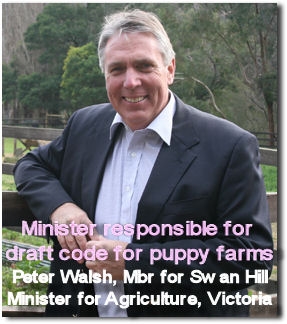 I and many of the caring members of the public, would like to see the end of intensive breeding of dogs and cats for domestic sales. Why, when we have shelters overloaded and excessive numbers of animals being dumped and on death row, should these "businesses" operate anyway?
I and many of the caring members of the public, would like to see the end of intensive breeding of dogs and cats for domestic sales. Why, when we have shelters overloaded and excessive numbers of animals being dumped and on death row, should these "businesses" operate anyway?



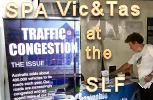 Once again members of the Victorian and Tasmanian Branch of Sustainable Population Australia braved the usual dreadful hot conditions at the Sustainable Living Festival in Melbourne, which has just come to an end.
Once again members of the Victorian and Tasmanian Branch of Sustainable Population Australia braved the usual dreadful hot conditions at the Sustainable Living Festival in Melbourne, which has just come to an end.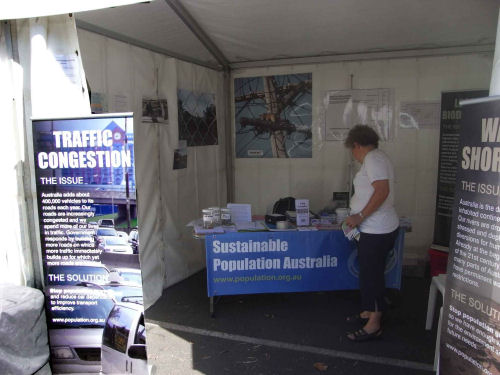
 As we understand it, individual States are free to “manage” their own (protected) wildlife. However, the "management" of wildlife ends up evolving into a business of exponential commercial proportions, with momentum to keep supplying the meat and skins for domestic use and international export markets. (Photographs by Brett Clifton)
As we understand it, individual States are free to “manage” their own (protected) wildlife. However, the "management" of wildlife ends up evolving into a business of exponential commercial proportions, with momentum to keep supplying the meat and skins for domestic use and international export markets. (Photographs by Brett Clifton) (Photographs by Brett Clifton)[1]
(Photographs by Brett Clifton)[1]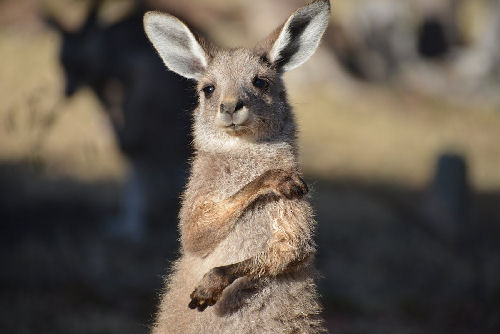



 There is a breeding colony of grey headed flying foxes at Bairnsdale in poplar trees along the bank of the Mitchell River in Bairnsdale. It is now threatened by the East Gippsland Shire. This article, by Bob McDonald, contains a fascinating history of flying fox colonies in early Victoria, as well as some keen scientific observations. (Photos also by Bob McDonald.)
There is a breeding colony of grey headed flying foxes at Bairnsdale in poplar trees along the bank of the Mitchell River in Bairnsdale. It is now threatened by the East Gippsland Shire. This article, by Bob McDonald, contains a fascinating history of flying fox colonies in early Victoria, as well as some keen scientific observations. (Photos also by Bob McDonald.)
 In her submission to the Victorian State Department of Planning and Community Services, Julianne Bell, Secretary of
In her submission to the Victorian State Department of Planning and Community Services, Julianne Bell, Secretary of 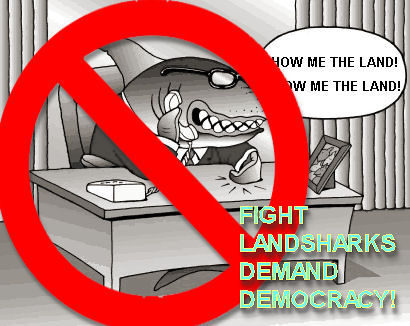
 The Government and opposition's population engineering continues to wreck havoc on democracy and land-tenure, affecting both private property and public lands, and impacting on established low-key local commerce. New proposed uses for the Green Wedge actually include saw-mills and display homes. The Flinders Community Association have begun issuing an information-packed alert for distribution to the local community detailing the damage that State Government changes to our Green Wedges can do to peoples' local natural, social and commercial environment, whilst removing their ability to defend what is theirs. Other communities may wish to take a similar democratic initiative before all our rights to self-government are swept away by unjust legislation to benefit developers. Note that these moves were begun by the previous Labor Government - which is hardly fighting them now. The incumbent government should be rolling back what Bracks and Brumby did, but instead, they are making things worse.MEETING IN FLINDERS COMMUNITY HALL 4 PM SATURDAY SEPTEMBER 15th 2012
The Government and opposition's population engineering continues to wreck havoc on democracy and land-tenure, affecting both private property and public lands, and impacting on established low-key local commerce. New proposed uses for the Green Wedge actually include saw-mills and display homes. The Flinders Community Association have begun issuing an information-packed alert for distribution to the local community detailing the damage that State Government changes to our Green Wedges can do to peoples' local natural, social and commercial environment, whilst removing their ability to defend what is theirs. Other communities may wish to take a similar democratic initiative before all our rights to self-government are swept away by unjust legislation to benefit developers. Note that these moves were begun by the previous Labor Government - which is hardly fighting them now. The incumbent government should be rolling back what Bracks and Brumby did, but instead, they are making things worse.MEETING IN FLINDERS COMMUNITY HALL 4 PM SATURDAY SEPTEMBER 15th 2012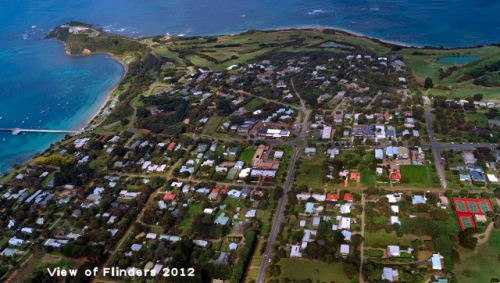
 On the ABC News radio this morning (9 Sept 2012) we heard that private coal companies are demanding compensation for carbon trading costs from the Victorian Government and apparently this is being taken seriously!
On the ABC News radio this morning (9 Sept 2012) we heard that private coal companies are demanding compensation for carbon trading costs from the Victorian Government and apparently this is being taken seriously!
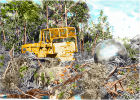 The Growling Grass Frog, one of the largest frog species in Australia, was previously widespread across Victoria. They are now endangered. Southern Brown Bandicoots once occurred commonly in the wider Frankston area (pre-1970s). They have rapidly declined and are now restricted to isolated remnant habitat patches. They have little chance of long term survival against the economic benefits of population growth. Without robust ecosystems, with each natural species contributing its part to the web of life, we end in a barren, artificial and sterile, wastelands. (First posted
The Growling Grass Frog, one of the largest frog species in Australia, was previously widespread across Victoria. They are now endangered. Southern Brown Bandicoots once occurred commonly in the wider Frankston area (pre-1970s). They have rapidly declined and are now restricted to isolated remnant habitat patches. They have little chance of long term survival against the economic benefits of population growth. Without robust ecosystems, with each natural species contributing its part to the web of life, we end in a barren, artificial and sterile, wastelands. (First posted
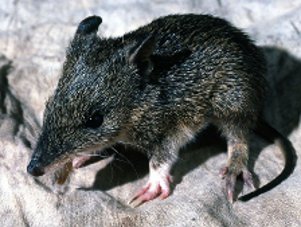
 Please, please follow the recommendations of Jill Redwood and Environment East Gippsland. All of the incredible battles won, rare animals and precious forests will be trashed unless we prevent this new legislation.
Please, please follow the recommendations of Jill Redwood and Environment East Gippsland. All of the incredible battles won, rare animals and precious forests will be trashed unless we prevent this new legislation.
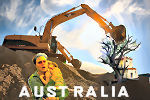 Federal Labor Member for Wills, Kelvin Thomson, has condemned reports in an article by Josh Gordon,
Federal Labor Member for Wills, Kelvin Thomson, has condemned reports in an article by Josh Gordon, 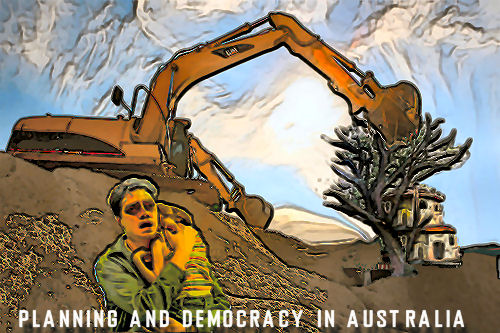
 Have you spent a lot of time on the Mornington Peninsula, but never heard of Tootgarook Swamp or its values? If your answer is yes, well you aren't the only ones. We were in that position a few months ago too and here is what we've learned since then.
Have you spent a lot of time on the Mornington Peninsula, but never heard of Tootgarook Swamp or its values? If your answer is yes, well you aren't the only ones. We were in that position a few months ago too and here is what we've learned since then.
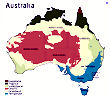 "Despite this grim picture, unlike global population growth, our own population future is very much under our control and we need not be overwhelmed. Stability of population numbers is within our reach this century. We owe it to Victorians who will be born 50 years from now to take control so that those who come after us can enjoy what we have enjoyed – clean air and water and reliable food and housing supplies. To do nothing is the real crime against humanity." Jill Quirk, President, Sustainable Population Australia (SPA) Victoria.
"Despite this grim picture, unlike global population growth, our own population future is very much under our control and we need not be overwhelmed. Stability of population numbers is within our reach this century. We owe it to Victorians who will be born 50 years from now to take control so that those who come after us can enjoy what we have enjoyed – clean air and water and reliable food and housing supplies. To do nothing is the real crime against humanity." Jill Quirk, President, Sustainable Population Australia (SPA) Victoria.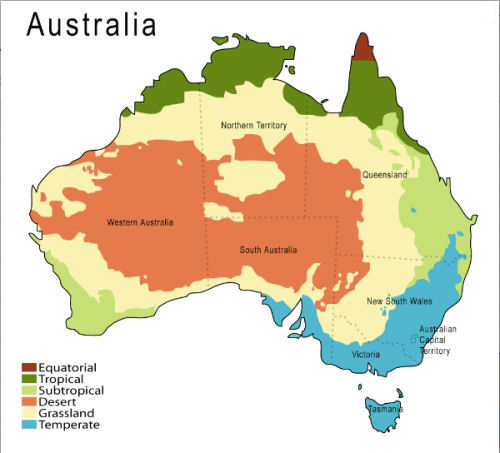

 Watch the trailer here
Watch the trailer here Participants were shocked recently to hear Ms Prue Digby, Deputy Secretary, Planning and Local Government, Department of Planning and Community Development include in her paper on "housing a growing population" a section on "eliminating the NIMBY culture" at the Informa Australia "Population Australia - 2050 Summit." Article by Julianne Bell.
Participants were shocked recently to hear Ms Prue Digby, Deputy Secretary, Planning and Local Government, Department of Planning and Community Development include in her paper on "housing a growing population" a section on "eliminating the NIMBY culture" at the Informa Australia "Population Australia - 2050 Summit." Article by Julianne Bell.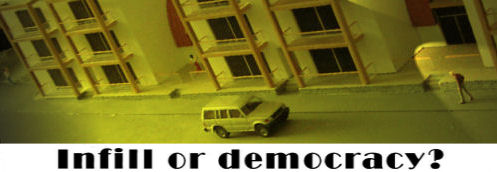
 Andrew Chapman is calling for a Royal Commission into the Victorian (Wonthaggi) Desalination Plant. We publish here his comments and some early discussion. We also publish some correspondence with Tim Holding, the Minister for Water under the Brumby government. There seems to be wide support for a royal commission into the matter, which is perceived widely as corrupt. The matter of desalination plants is a huge one in Australia where such plants, not necessary when we had a population of 17m only a decade ago, have been introduced in nearly every state with the excuse that our growing population requires them. The public have not been adequately consulted on the population growth induced by ill-considered government policy nor on the introduction of these plants themselves. What is for sure is that almost no-one likes these plants and governments are bitterly resented for having forced them on Australians.
Andrew Chapman is calling for a Royal Commission into the Victorian (Wonthaggi) Desalination Plant. We publish here his comments and some early discussion. We also publish some correspondence with Tim Holding, the Minister for Water under the Brumby government. There seems to be wide support for a royal commission into the matter, which is perceived widely as corrupt. The matter of desalination plants is a huge one in Australia where such plants, not necessary when we had a population of 17m only a decade ago, have been introduced in nearly every state with the excuse that our growing population requires them. The public have not been adequately consulted on the population growth induced by ill-considered government policy nor on the introduction of these plants themselves. What is for sure is that almost no-one likes these plants and governments are bitterly resented for having forced them on Australians. 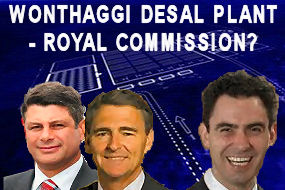

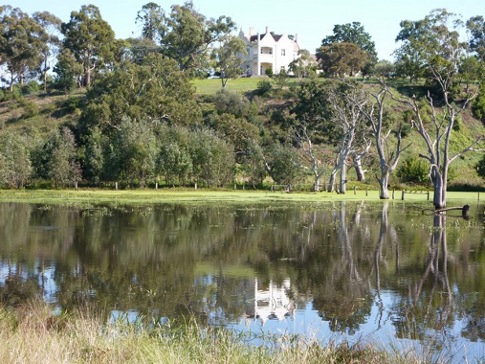
Recent comments